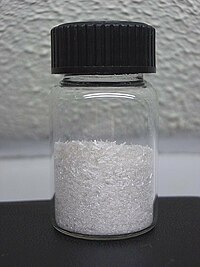Hydroquinone
 |
|
 |
|
 |
|
| Names | |
|---|---|
|
Preferred IUPAC name
Benzene-1,4-diol
|
|
| Other names
Hydroquinone
Idrochinone Quinol 1,4-Dihydroxybenzene 1,4-Hydroxy benzene |
|
| Identifiers | |
|
123-31-9 |
|
| 3D model (Jmol) | Interactive image |
| ChEBI |
CHEBI:17594 |
| ChEMBL |
ChEMBL537 |
| ChemSpider |
764 |
| ECHA InfoCard | 100.004.199 |
| KEGG |
D00073 |
| RTECS number | MX3500000 |
| UNII |
XV74C1N1AE |
|
|
|
|
| Properties | |
| C6H6O2 | |
| Molar mass | 110.11 g·mol−1 |
| Appearance | white solid |
| Density | 1.3 g cm−3, solid |
| Melting point | 172 °C (342 °F; 445 K) |
| Boiling point | 287 °C (549 °F; 560 K) |
| 5.9 g/100 mL (15 °C) | |
| Vapor pressure | 0.00001 mmHg (20°C) |
| -64.63·10−6 cm3/mol | |
| Structure | |
| 1.4±0.1 D | |
| Pharmacology | |
| D11AX11 (WHO) | |
| Hazards | |
|
EU classification (DSD)
|
Harmful (Xn) Carc. Cat. 3 Muta. Cat. 3 Dangerous for the environment (N) |
| R-phrases | R22 R40 R41 R43 R50 R68 |
| S-phrases | (S2) S26 S36/37/39 S61 |
| NFPA 704 | |
| Flash point | 165 °C (329 °F; 438 K) |
| Lethal dose or concentration (LD, LC): | |
|
LD50 (median dose)
|
490 mg/kg (mammal, oral) 245 mg/kg (mouse, oral) 200 mg/kg (rabbit, oral) 320 mg/kg (rat, oral) 550 mg/kg (guinea pig, oral) 200 mg/kg (dog, oral) 70 mg/kg (cat, oral) |
| US health exposure limits (NIOSH): | |
|
PEL (Permissible)
|
TWA 2 mg/m3 |
|
REL (Recommended)
|
C 2 mg/m3 [15-minute] |
|
IDLH (Immediate danger)
|
50 mg/m3 |
| Related compounds | |
|
Related benzenediols
|
Pyrocatechol Resorcinol |
|
Related compounds
|
1,4-benzoquinone |
|
Except where otherwise noted, data are given for materials in their standard state (at 25 °C [77 °F], 100 kPa).
|
|
|
|
|
| Infobox references | |
Hydroquinone, also benzene-1,4-diol or quinol, is an aromatic organic compound that is a type of phenol, a derivative of benzene, having the chemical formula C6H4(OH)2. Its chemical structure, shown in the table at right, features two hydroxyl groups bonded to a benzene ring in a para position. It is a white granular solid. Substituted derivatives of this parent compound are also referred to as hydroquinones. The name "hydroquinone" was coined by Friedrich Wöhler in 1843.
Hydroquinone is produced industrially by two main routes.
Other, less common methods include:
The reactivity of hydroquinone's O-H groups resembles other phenols, being weakly acidic. The resulting conjugate base undergoes easy O-alkylation to give mono- and diethers. Similarly, hydroquinone is highly susceptible to ring substitution by Friedel-Crafts reactions such as alkylation. This reaction is exploited en route to popular antioxidants such as 2-tert-butyl-4-methoxyphenol ("BHA"). The useful dye quinizarin is produced by diacylation of hydroquinone with phthalic anhydride
Hydroquinone undergoes oxidation under mild conditions to give benzoquinone. This process can be reversed. Some naturally occurring hydroquinone derivatives exhibit this sort of reactivity, one example being coenzyme Q. Industrially this reaction is exploited both with hydroquinone itself but more often with its derivatives where one OH has been replaced by an amine.
...
Wikipedia

